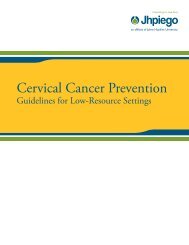Manual for Male Circumcision under Local Anaesthesia
Manual for Male Circumcision under Local Anaesthesia
Manual for Male Circumcision under Local Anaesthesia
You also want an ePaper? Increase the reach of your titles
YUMPU automatically turns print PDFs into web optimized ePapers that Google loves.
<strong>Male</strong> circumcision <strong>under</strong> local anaesthesia<br />
Version 3.1(Dec09)<br />
PREFACE<br />
<strong>Male</strong> circumcision has been per<strong>for</strong>med on boys and young men <strong>for</strong> many years, primarily <strong>for</strong><br />
religious and cultural reasons or as a rite of passage to mark the transition to adulthood.<br />
Data from cross-sectional epidemiological studies conducted since the mid-1980s showed<br />
that circumcised men have a lower prevalence of HIV infection than uncircumcised men.<br />
This finding was supported by data from prospective studies that showed a lower incidence<br />
of HIV infection in circumcised men than in uncircumcised men. Although the analysis<br />
adjusted <strong>for</strong> cultural and social factors associated with male circumcision, it was not clear<br />
from these studies whether promoting male circumcision among men who would not<br />
otherwise be circumcised would result in a lower incidence of HIV infection. To address this<br />
question, three randomized controlled trials were launched in Kenya, Uganda and South<br />
Africa in 2004. The results from the South African study were published in late 2005, and<br />
showed a 60% lower incidence of HIV infection among men randomly assigned to <strong>under</strong>go<br />
immediate circumcision compared with those assigned to delayed circumcision.<br />
Confirmatory results from the two other trials were released in December 2006. These data<br />
led WHO and UNAIDS to recommend in 2007 that male circumcision should be considered<br />
an additional way of reducing risk of HIV infection in men and programmes <strong>for</strong> safe male<br />
circumcision should be expanded rapidly in countries and settings with generalized HIV<br />
epidemics and low prevalence of circumcision.<br />
There is increased demand <strong>for</strong> male circumcision in several countries with a high incidence<br />
of HIV, but there is little technical guidance on how services can be safely expanded given<br />
the limited resources available. Reports of high complication rates following circumcisions<br />
per<strong>for</strong>med on young men by traditional circumcisers in southern and eastern Africa are<br />
common, but the true incidence is not known. Technical guidance on the provision of safe<br />
male circumcision services is there<strong>for</strong>e necessary. Although circumcisions are widely<br />
per<strong>for</strong>med by surgeons and general practitioners in an appropriate clinical environment,<br />
resources are not currently adequate to meet the anticipated increased demand.<br />
This technical manual on male circumcision is aimed at providers of male circumcision<br />
services and programme managers. No attempt is made to describe all possible methods <strong>for</strong><br />
male circumcision. The methods covered have been selected on the basis of their safety and<br />
practicality <strong>for</strong> use in resource-limited settings. The manual <strong>for</strong>ms part of a comprehensive<br />
package, which includes training guides and materials, as well as a male circumcision<br />
quality improvement framework <strong>for</strong> use by providers, programme managers and national<br />
medical authorities to ensure high-quality services. While providing detailed technical<br />
in<strong>for</strong>mation on the different surgical approaches, the manual also addresses broader issues<br />
of sexual and reproductive health of men, and emphasizes that male circumcision must be<br />
set within the context of other strategies <strong>for</strong> reducing risk of HIV infection. A full description<br />
of best practices <strong>for</strong> surgery and anaesthesia in resource-limited settings can be found in the<br />
WHO publication, Surgical care at the district hospital (Geneva, WHO, 2003).<br />
The manual has been developed by the World Health Organization (WHO), in collaboration<br />
with the Joint United Nations Programme on HIV/AIDS (UNAIDS) and Jhpiego, as part of<br />
work to support countries in providing safe male circumcision services, and ensuring that<br />
circumcised men do not perceive themselves as fully protected against HIV and other<br />
sexually transmitted infections and consequently <strong>for</strong>go other HIV risk-reduction strategies.<br />
The manual was developed from reproductive health and surgery training materials, as well<br />
as on the basis of experience with service provision in Africa, the Eastern Mediterranean,<br />
Page vii
















